How to Make a Subway Map with John Tauranac
Hear from an author and map designer who has been creating maps of the NYC subway, officially and unofficially, for over forty years!



Photo by Iwan Baan for the Museum of the City of New York Saving Place: Fifty Years of New York City Landmarks
On April 21st at the Museum of the City of New York, the exciting new exhibition Saving Place: Fifty Years of New York City Landmarks will open, exploring how the pioneering landmarks legislation, passed in 1965, has been a key contributor to the rebirth of many New York City neighborhoods. More than just a historical recounting of the transformative law, Saving Place will look at how the impact of the landmarks law is woven into the urban fabric of the city today. Via the curation of original documents, drawings, paintings, videos, building pieces, paintings and more, the exhibition will situate history within the modern context.
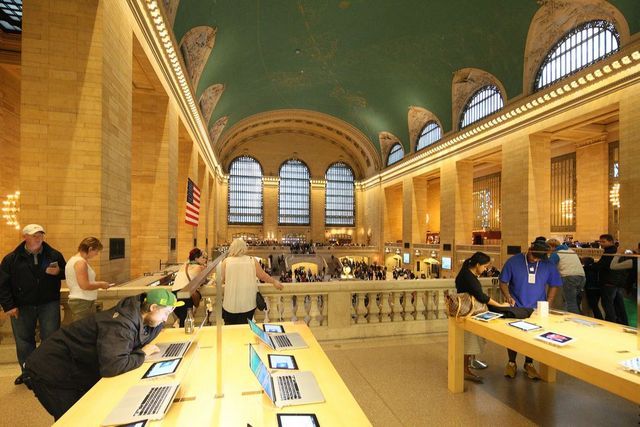
Grand Central Terminal, view from Apple Store. Photo by Iwan Baan for the Museum of the City of New York Saving Place: Fifty Years of New York City Landmarks
Fundamental to the exhibition is an inquiry into the coexistence of old and new in the city and the creative solutions developed by architects to both adaptively reuse existing buildings and integrate new construction into landmarked neighborhoods. Present-day photographs by renowned architectural photographer Iwan Baan, commissioned by the Museum of the City of New York, show how the city’s landmarks serve as symbols of neighborhood vitality while also embedded within the built environment. In addition, over ninety architectural fragments of city landmarks lost and still standing, like the original Pennsylvania Station and Carnegie Hall will be on display.
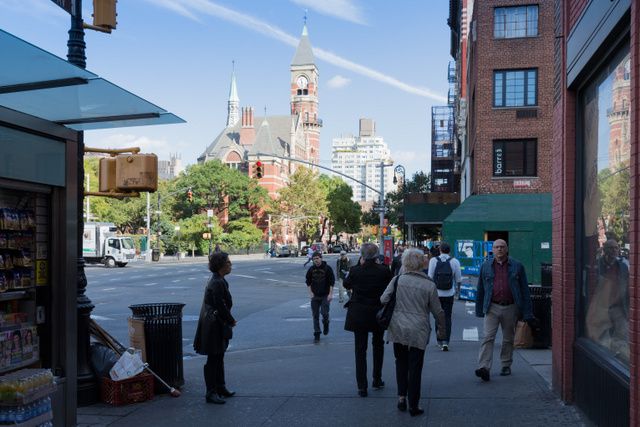
Jefferson Market Library, Greenwich Village photo by Iwan Baan for the Museum of the City of New York Saving Place: Fifty Years of New York City Landmarks
We had the opportunity to speak to two of the curators of Saving Place: Fifty Years of New York City Landmarks, Donald Albrecht, Curator of Architecture and Design at the Museum of the City of New York, and Andrew S. Dolkart, co-curator and Director of the Historic Preservation Program at Columbia University. In the following interview, you’ll find out what the curators think will surprise even seasoned New Yorkers, what they hope will be conveyed by the exhibition and more.
Dolkart: [I hope this exhibition will convey] the importance of the preservation movement to New York City. The fact that establishing a Landmarks Commission and keeping it effective is the job of the citizens of New York City and that we cannot take it for granted that the character of the city will be preserved. Also, the landmark designation is not about freezing the city or creating a museum, but that it is about using the past to create a dynamic present and future for the city, evident in the significant amount of new design and construction that has taken place in historic districts across the city.
Albrecht: The goal of the show is I would say, three-fold. One is to show the history of the preservation movement in New York and its origins. In other words, the notion that the Landmarks Commission was started and the law was passed because of the destruction of Penn Station is not true. Penn Station was one of many milestones–it was a significant milestone. But we’re going to give the trajectory and the people involved, the battles, the buildings that were lost, the buildings that were saved, how preservation worked within an ever-evolving metropolis, which is what New York is, from the end of the 19th century to the present day. And that’s done in the exhibition as a 3-dimensional timeline that lines the walls of the gallery.
Then a major second component of the show is to look and ask, “Okay, once the law was passed, how have architects, designer, owners and developers responded to the law by adding on to historic landmarks, restoring and retrofitting historic buildings, and building new architecture in historic districts. And that’s a very large component–a big architectural story, and that’s where I was particularly involved. That’s where we get models, drawings, photographs, and samples of building components.
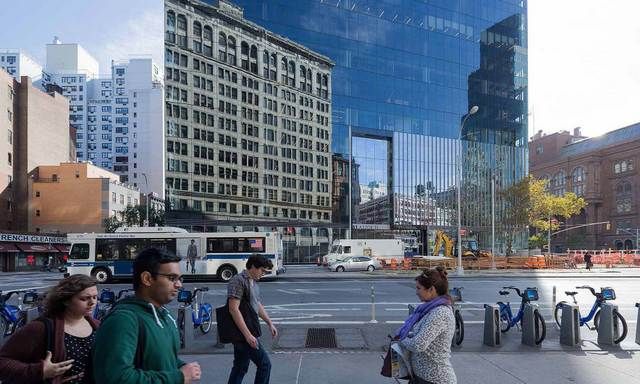
Astor Place, photo by Iwan Baan for the Museum of the City of New York Saving Place: Fifty Years of New York City Landmarks
The third component of the show is a series of new photographs that we commissioned [from] a well-known photographer named Iwan Baan. He came to New York in October 2014 for two weeks and we even rented him a helicopter. He went all over the city to every borough, looking at landmarks in action. How do historic buildings and how do historic districts function within a contemporary urbanism in New York? How do they add to the mix of old and new that characterizes New York today and makes it interesting for the people who live here, but also make it interesting for tourists who [for example] come to see a new Broadway play but go to see it in what is basically a series of historically preserved theaters? The dynamic mix of old and new that characterizes New York is captured in these new photographs, and they’ll be given prominence in the show.
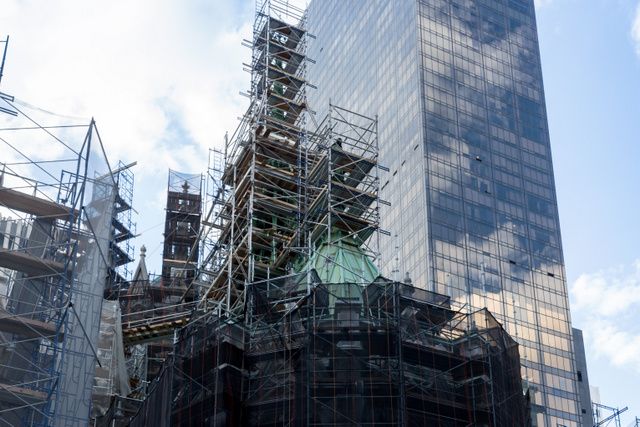
St. Patrick’s Cathedral under renovation, photo by Iwan Baan for the Museum of the City of New York Saving Place: Fifty Years of New York City Landmarks
So our goal was not to do a kind of library show of old documents, but to show the preservation movement as a dynamic movement within a city that everyone acknowledges is not–we’re not turning it into downtown Charleston–it is an historic city but it’s a modern city and how do you manage change in that kind of situation, and how do you accept change and move forward? So if you look at the buildings that are being built in historic districts, there are different strategies. Some mimic the historic buildings being added onto, and some are very dramatic juxtapositions.
Check out the exhibit Saving Place: Fifty Years of New York City Landmarks, opening April 21st, 2015 at the Museum of the City of New York. Read on for more of the interview with the curators:
Albrecht: Oh, from the beginning, yes. The first building built in an historic district was designed by architect Ulrich Franzen. It was the Jehovah’s Witness dormitory in Brooklyn Heights. The first design was very historical, looked like the existing buildings and the community rejected it. They went to the Jehovah’s Witness and they said, we think you should get a very good contemporary architect who will do something which is contextual, but looks like it’s of our own time. So if you look at the Ulrich Franzen building, it’s made of masonry like the historic buildings, it has windows that are like stripes that relate to the windows of the historic building. It uses the historic building as a jumping off point for a modern building and that was done in the late ’60s.
Albrecht: This is by far the largest and most comprehensive of the exhibitions happening and we are also opening it with a major symposium that features Michael Kimmelman from The New York Times, the architect Robert A. M. Stern, Steven Spinola, the head of the Real Estate Board of New York, [Vishaan Chakrabarti, principal at SHoP Architects and Director of CURE at Columbia Univeristy, Roberta Brandes Gratz, an urban critic and journalist, and Adele Chatfield-Taylor, former president and CEO of the American Academy in Rome]. So that will be a significant kick off on April 20th.
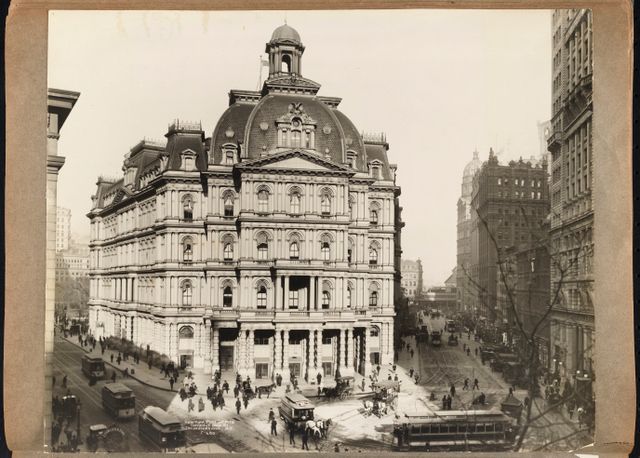
Demolished City Hall Post Office, so hated it was known as “Mullet’s Monstrosity,” after the architect. Photo by Irving Underhill from Museum of the City of New York Collections.
Dolkart: The breadth of landmarks in New York, the role of every day New Yorkers in creating the Commission, the long history of preservation concerns before Penn Station and the need for vigilance in protecting the city’s heritage and its landmarks law.
Albrecht: They’ll probably be surprised by the fact that the preservation movement begins many years before. There’s a lot of movement happening in the teens and ‘20s, and what was saved at that time were often buildings of historical significance–the “George Washington slept here” phenomenon. Then, 1945 comes along and New York City goes through an enormous construction boom because of the booming economy of the city and that’s a different chapter. A lot of great buildings are being torn down in the wake of that and that’s what really sparks the landmarks law. And then they may be interested to see how it works in action, why the Jewish Museum addition looks the way it does versus why the Hearst Tower looks the way it does.
I think it’s one of those shows that we’ve typically done that [shows] “what’s hidden in plain sight,” and they get to see the city in a different way. And also, I was surprised that there are little historic districts in the Bronx that are like a street long. Also they may be surprised that they actually were going to tear down Grand Central Terminal at one point. What the preservation movement is about and what it was about in the past is more than you think it is.
Donald Albrecht: I am the Museum’s curator of architecture and design and I do many of the architecture and design shows. Andrew, however is an expert in preservation, which I am not, so we thought it was a good pairing. I, on the other hand have done many more exhibitions so I know how to make a show out of it. We do this oftentimes– shows where we pair a curator with a knowledge of architecture and design or a knowledge of a particular subject, and an expert in that subject. That’s how this has been organized, and it’s been a great collaboration.
Andrew S. Dolkart: We were co-curators. I brought my long-time knowledge of the preservation movement in New York City and the Landmarks Preservation Commission in particular.
Albrecht: We’ve worked where I come up with a way of presenting an idea, or I work with the designers, and then Andrew and I work together on the specific dimensions of the projects to be featured.
![[TWA Flight Center.]](https://www.untappedcities.com/content/images/wp-content/uploads/2015/04/saving-place-iwan-baan-twa-flight-center-jfk-airport-nyc-landmarks-law-50th-anniversary-museum-of-city-of-new-york-exhibition.jpg)
TWA Flight Center at JFK Airport, a building saved and landmarked. Photo by Edmund Vincent Gillon from Museum of the City of New York Collections.
Yes, I’ve done many exhibitions and books about mid-20th century architecture and design, a period I’m interested in both culturally and stylistically. That’s when New York City becomes the international cultural capital it is today. Saving Place relates to that subject because it explores efforts to preserve the city’s heritage in the face of tremendous change. As New York continues to change, it’s a story as relevant today, and it was throughout the 20th century.
Saving Place: Fifty Years of New York City Landmarks will launch with the symposium “Redefining Preservation for the 21st Century” on April 20th at 5:30pm. Tickets will include admission to the opening reception of Saving Place after at the Museum of City of New York. A book, Saving Place: 50 Years of New York City Landmarks has been published by Monacelli Press in conjunction with the exhibition. Stay tuned for a weekly series covering a different aspect of Saving Place: Fifty Years of New York City Landmarks, from an exhibition review next week to an in-depth look at the architectural fragments on display, which include a marble eagle head of Penn Station.
Subscribe to our newsletter